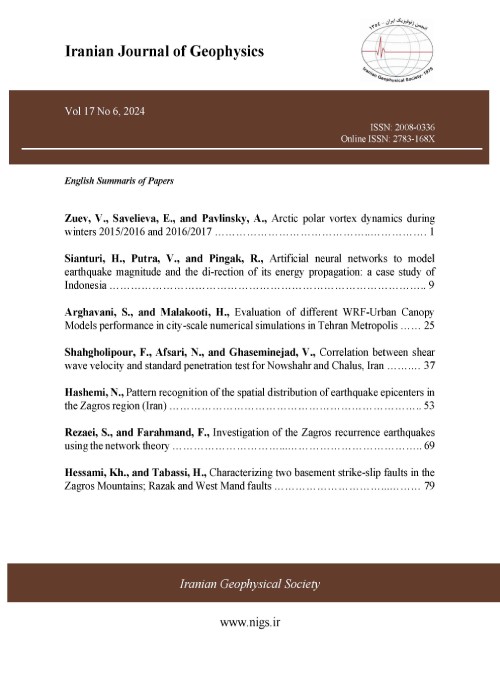A case study on the impact of synoptic and upper air data assimilation in WRF output for precipitation over Iran
Author(s):
Abstract:
Numerical weather prediction is an initial-boundary value problem. Hence, to estimate the future state of the atmosphere, its current state with as much accuracy as possible should be known. Part of the error in the outputs of limited area models is due to the imperfect initial conditions. Many researches have been conducted to develop various methods for improving the accuracy and quality of the initial conditions. At the time being, operational weather forecasting centers combine short-range weather forecasts and available observations using statistical methods to provide the initial conditions. This approach is known as data assimilation, whose purpose is defined by Talagrand (1997) as using all the available information, to determine as accurately as possible the state of the atmospheric (or oceanic) flow. In general, there are two strategies for data assimilation; intermittent and continuous approaches. In the intermittent approach, some sort of analysisschemes, such as successive correction, optimum interpolation or 3-dimensional variational (3D-VAR) is used to combine a short-range forecast as the background field with observations. The new analysis is then used as the initial condition of the model which is integrated forward in time. The resulted forecast may be used as the new first-guess for the next analysis. The analysis time intervals for such schemes typically range from 1 hr to 12 hrs. Disadvantages of such schemes, especially in the mesoscale, include analysis balance constraints, model spin-up, data sparseness, and data usage constraints. In continuous assimilation methods, on the other hand, one is able to assimilate observational data at its valid time, and produce smoothly varying model fields in all 4 dimensions. Due to the time-continuous aspect of such scheme, the model spin-up problem could be eliminated, and all available observations are used at their valid time. Since the model adjusts dynamically; inappropriate larger scale balances are not imposed. Examples of continuous assimilation methodologies include 4-dimensional variational (4DVAR) methods and Newtonian relaxation of observations called observation nudging. The former is expensive computationally and may not be feasible for real-time or operational assimilation systems. The Newtonian relaxation technique is described well in Stauffer and Seaman (1990), including the differences between analysis nudging and observation nudging. Analysis nudging is often considered to be a continuous assimilation method because the analyses are nudged into the model continuously over time. However, the analysis itself is a one-time product and thus analysis nudging has many of the disadvantages associated with intermittent assimilation schemes, including data sparseness and balance issues. One of the main disadvantages of observation nudging schemes is that the observations must be of a model variable, or directly convertible to one. Indirect observations, such as satellite-measured radiances, cannot be assimilated via observation nudging. In this paper, it is attempted to assimilate surface and upper air observations over Iran to estimate the initial condition of the model and prepare predictions with higher accuracy. The WRF mesoscale model was run for four selected cases to produce 72-h weather predictions with and without data assimilation. The model outputs are compared against corresponding verifying observations. Results showed significant improvements in precipitation forecasts when data assimilation is used, such that forecasted precipitation patterns look more similar to the observed ones. Also, calculated statistical verification scores showed around 18 and 15 percent improvement in the mean error (ME) and mean absolute error (MAE) respectively.
Keywords:
Language:
Persian
Published:
Iranian Journal of Geophysics, Volume:10 Issue: 2, 2016
Pages:
110 to 119
magiran.com/p1572720
دانلود و مطالعه متن این مقاله با یکی از روشهای زیر امکان پذیر است:
اشتراک شخصی
با عضویت و پرداخت آنلاین حق اشتراک یکساله به مبلغ 1,390,000ريال میتوانید 70 عنوان مطلب دانلود کنید!
اشتراک سازمانی
به کتابخانه دانشگاه یا محل کار خود پیشنهاد کنید تا اشتراک سازمانی این پایگاه را برای دسترسی نامحدود همه کاربران به متن مطالب تهیه نمایند!
توجه!
- حق عضویت دریافتی صرف حمایت از نشریات عضو و نگهداری، تکمیل و توسعه مگیران میشود.
- پرداخت حق اشتراک و دانلود مقالات اجازه بازنشر آن در سایر رسانههای چاپی و دیجیتال را به کاربر نمیدهد.
In order to view content subscription is required
Personal subscription
Subscribe magiran.com for 70 € euros via PayPal and download 70 articles during a year.
Organization subscription
Please contact us to subscribe your university or library for unlimited access!



